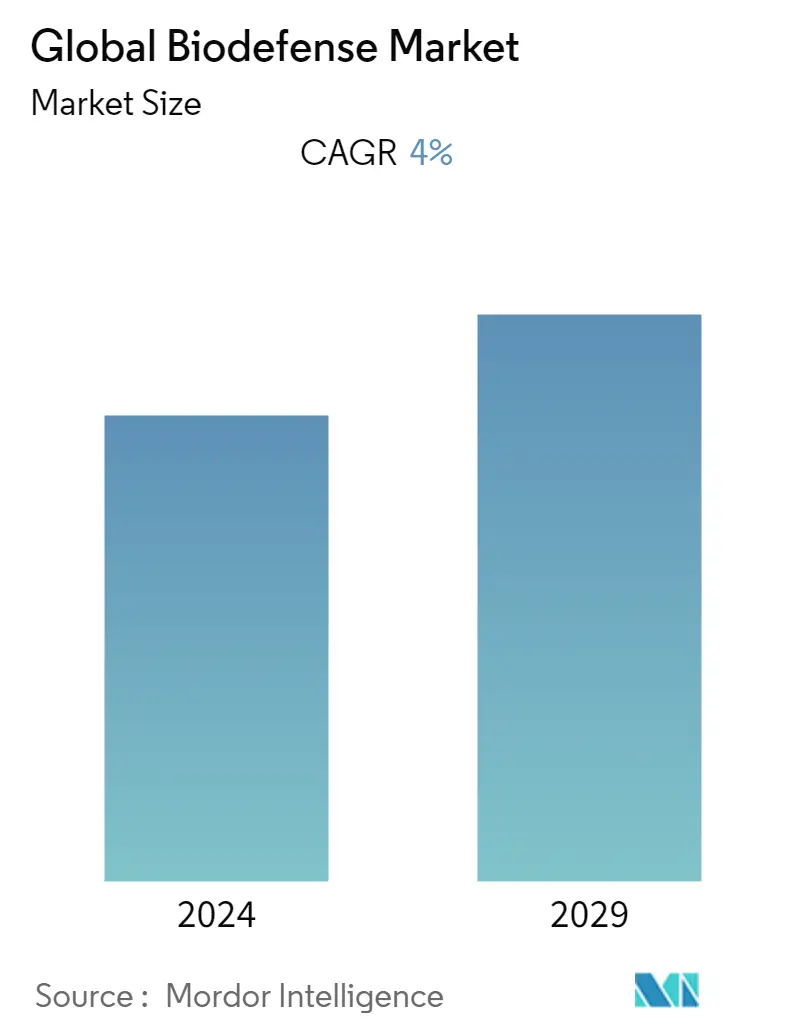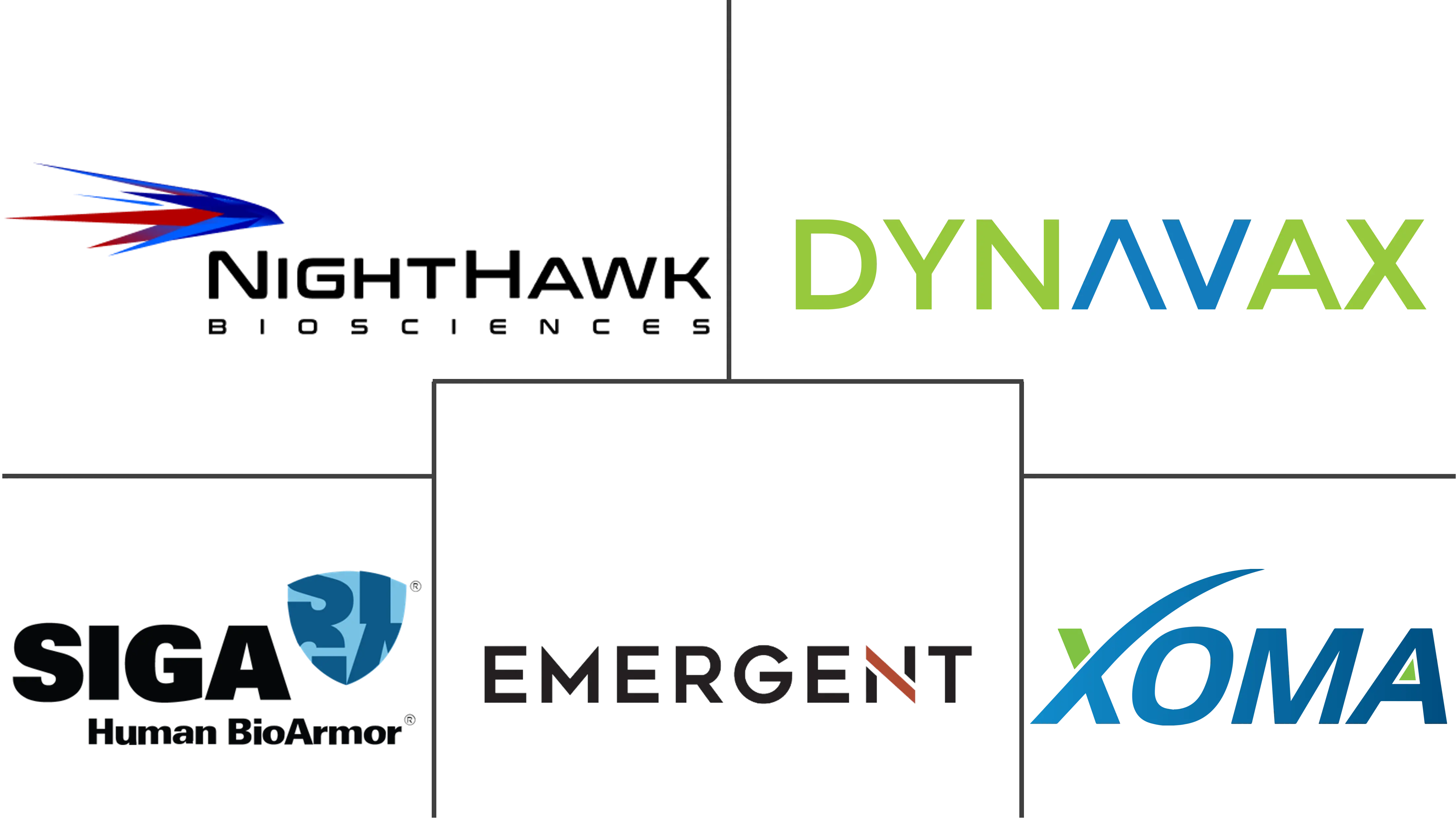Market Size of Global Biodefense Industry

| Study Period | 2019 - 2029 |
| Base Year For Estimation | 2023 |
| Forecast Data Period | 2024 - 2029 |
| CAGR | 4.00 % |
| Fastest Growing Market | Europe |
| Largest Market | North America |
Major Players
*Disclaimer: Major Players sorted in no particular order |
Need a report that reflects how COVID-19 has impacted this market and its growth?
Biodefense Market Analysis
The biodefense market is expected to record a CAGR of 4% over the forecast period.
COVID-19 had a significant impact on the overall healthcare industry. As per the article published in May 2022 by Disaster Medicine Public Health emergency, the COVID-19 pandemic's emergence has had a big impact on people's lives and the stability of the economy and society. The study depicted that during the pandemic outbreak, there was a shortage of testing and surveillance, leading to a common issue in the whole healthcare system. For the United States and its foreign interests, biothreats are anticipated to continue to be complicated and serious threats. Hence, COVID-19 had a significant impact on the biodefense market. Currently, since the lockdown restrictions were lifted, the industry has been recovering well. To combat rising biothreats, many countries have invested in modernizing biodefense infrastructure to replicate and support public health emergency preparation activities and, thus, are expected to boost the market in the coming years. For instance, in January 2022, integrated Viral Protection (IVP), a Texas-based technology business, released a new portable air filtration equipment that can eliminate airborne viruses in a single pass, including sub-micron versions producing COVID-19, anthrax spores, allergens, and other dangerous respiratory triggers. The patented biodefense indoor air protection system apparently eradicates SARS-CoV-2 (99.999%), anthrax spores (99.98%), and other airborne infections in a single pass.
The biodefense market is driven by factors such as the presence of favorable government initiatives, increasing investment by governments in developed countries, and rapid technological advancements. For instance, Emergent Bioscience announced that, for Q1 2022, revenues from Anthrax vaccines increased by USD 48.6 million as compared to Q1 2021. The increase is largely driven by the timing of deliveries to the United States government (USG), specifically the Strategic National Stockpile (SNS). Moreover, the company received an AV7909 (Anthrax Vaccine Adsorbed, Adjuvanted) contract modification in September 2021 valued at approximately USD 399 million to deliver additional AV7909 doses through March 2023.
Every year, governments are spending heavily on the R&D of vaccines to stay prepared for any bioterrorism attacks. Pharmaceutical companies operating in the biodefense market have huge opportunities to expand due to governments' drive to be prepared for any kind of bioterrorism. As per the 2022 news report, the Biden administration has prepared a new defense strategy against pandemics and other biological threats that applies lessons from COVID-19 and puts the white house at the center of any future United States. In June 2022, a revised National Biodefense Strategy was expected to provide clearer guidance on how the US government should respond to future health threats.
As per the factors mentioned above, the biodefense market is anticipated to witness growth over the forecast period. However, low penetration in developing and underdeveloped countries restrains the market growth.
Biodefense Industry Segmentation
As per the scope of the report, biodefense constitutes the use of medical measures to protect individuals against bioterrorism, including interventions such as drugs and vaccinations. Furthermore, there is an improvement in terms of research and public health preparations to defend against biological attacks. There is an increasing awareness regarding synthetic biology, mainly for using biological organisms to reduce the burden of diseases, especially for improving agricultural yields. The Biodefense Market is segmented by Product (Anthrax, Botulism, Smallpox, Nuclear, and Other Products) and Geography (North America, Europe, Asia-Pacific, Middle East, Africa, and South America). The market report also covers the estimated market sizes and trends for 17 countries across major regions globally. The report offers the value (in USD million) for the above segments.
| By Product | |
| Anthrax | |
| Botulism | |
| Smallpox | |
| Nuclear | |
| Other Products |
| Geography | ||||||||
| ||||||||
| ||||||||
| ||||||||
| ||||||||
|
Global Biodefense Market Size Summary
The biodefense market is poised for growth, driven by increased government investments and advancements in technology. The COVID-19 pandemic highlighted vulnerabilities in public health systems, prompting nations to enhance their biodefense infrastructure. This has led to a surge in demand for innovative solutions, such as portable air filtration systems capable of neutralizing airborne viruses. The market is further bolstered by favorable government initiatives and strategic collaborations in research and development. Companies like Emergent BioSolutions have reported significant revenue increases from anthrax vaccines, underscoring the market's potential. The focus on preparedness for bioterrorism and biological threats has created substantial opportunities for pharmaceutical companies to expand their offerings.
North America is expected to lead the market's growth, supported by robust government strategies and funding aimed at addressing biological threats. Initiatives like the National Biodefense Strategy and collaborations with pharmaceutical manufacturers to produce vaccines highlight the region's commitment to enhancing national security. The market's competitive landscape is characterized by the presence of key players such as Emergent BioSolutions and Siga Technologies, who are actively developing products to meet national biosecurity needs. Despite the market's fragmentation, the increasing government support and strategic acquisitions are likely to drive further expansion, particularly in the anthrax product segment, which remains a significant focus due to ongoing outbreaks and research collaborations.
Global Biodefense Market Size - Table of Contents
-
1. MARKET DYNAMICS
-
1.1 Market Overview
-
1.2 Market Drivers
-
1.2.1 Increasing Investment and Initiatives by the Governments in Developed Countries
-
1.2.2 Rapid Technological Advancements
-
-
1.3 Market Restraints
-
1.3.1 Low Penetration in Developing and Underdeveloped Countries
-
-
1.4 Porter Five Forces
-
1.4.1 Threat of New Entrants
-
1.4.2 Bargaining Power of Buyers/Consumers
-
1.4.3 Bargaining Power of Suppliers
-
1.4.4 Threat of Substitute Products
-
1.4.5 Intensity of Competitive Rivalry
-
-
-
2. MARKET SEGMENTATION (Market Size by Value - USD Million)
-
2.1 By Product
-
2.1.1 Anthrax
-
2.1.2 Botulism
-
2.1.3 Smallpox
-
2.1.4 Nuclear
-
2.1.5 Other Products
-
-
2.2 Geography
-
2.2.1 North America
-
2.2.1.1 United States
-
2.2.1.2 Canada
-
2.2.1.3 Mexico
-
-
2.2.2 Europe
-
2.2.2.1 Germany
-
2.2.2.2 United Kingdom
-
2.2.2.3 France
-
2.2.2.4 Italy
-
2.2.2.5 Spain
-
2.2.2.6 Rest of Europe
-
-
2.2.3 Asia-Pacific
-
2.2.3.1 China
-
2.2.3.2 Japan
-
2.2.3.3 India
-
2.2.3.4 Australia
-
2.2.3.5 South Korea
-
2.2.3.6 Rest of Asia-Pacific
-
-
2.2.4 Middle East and Africa
-
2.2.4.1 GCC
-
2.2.4.2 South Africa
-
2.2.4.3 Rest of Middle East and Africa
-
-
2.2.5 South America
-
2.2.5.1 Brazil
-
2.2.5.2 Argentina
-
2.2.5.3 Rest of South America
-
-
-
Global Biodefense Market Size FAQs
What is the current Global Biodefense Market size?
The Global Biodefense Market is projected to register a CAGR of 4% during the forecast period (2024-2029)
Who are the key players in Global Biodefense Market?
Siga Technologies Inc., Emergent BioSolutions Inc., Nighthawk Biosciences, Inc. (Elusys Therapeutics Inc.), XOMA Corporation and Dynavax Technologies are the major companies operating in the Global Biodefense Market.

